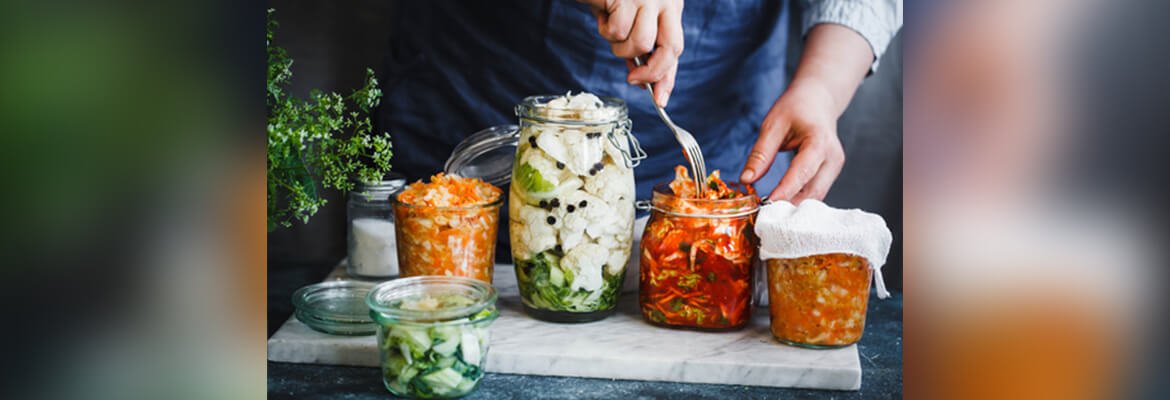16
2019
DIFFERENCE BETWEEN PICKLING AND FERMENTATION.

Difference between Pickling and Fermentation –
Pickling is a more ‘generic’ term referred to various ways of preserving food in an aidic medium. Pickling assumes a different meaning in the West versus the word ‘pickles’ used in India. Referred to as ‘aachar’ in India. It’s my firm belief that while Indian pickles started off s healthy, mutated along the way to just pleasing the taste. Some Indian Nutritionists (I say this with utmost respect) seem to be confusing this with the process of ‘lactic acid fermentation.’ Our Indian pickles are very different from the process of Lactic Acid Fermentation. Here is the difference –
It’s important to know the process of fermentation to understand the difference between Indian pickles and ‘pickles in brine (salt water)’ or ‘anaerobic fermentation’ like kimchi, brine pickles or sauerkraut. How does a vegetable become a pickle? All vegetables are covered with bacteria. During pickling –
- These bacteria grow while quashing the development of other bacteria that can cause spoiling. They use the sugars in the vegetables leaving none for harmful bacteria to grow. MOST INDIAN PICKLES ADD SUGAR/JAGGERY (done to encourage some bacterial growth. Mostly to add taste of sweetness) – THE FIRST REASON INDIAN PICKLES NEGATE THIS PROCESS BY USING THE SUGAR (encouraging good+depending on ingredients used some mixed bacterial strains bacteria).
- Salt water pickles (brine) or sauerkraut or kimchi use salt to encourage the process of ‘LACTOFERMENTATION’ encouraging lactic acid bacteria (LAB) to thrive outnumbering the bad bacteria; leaving the vegetables nutritional quotient intact and encouraging a pool of ‘new nutrients.’ Lactic acid preserves these nutrients, and also adds a tartness to the preparation. NOTE: Quick pickles in vinegar are classified as ‘quick pickle’ but not with the same bacterial strains as in a salt water brine pickle or the fermentation process used for sauerkraut and kimchi. AGAIN, THIS PROCESS IS NOT WHAT AN INDIAN PICKLE FOLLOWS. INDIAN PICKLES — COMMERCIAL OR MOST HOMEMADE use REFINED OIL, TO PRESERVE. REFINED OIL IS NOT EXACTLY THE BEST OPTION, So, change this to a cold pressed oil.
- BRINE OR THE METHODS USED IN A SAUERKARUT OR KIMCHI ARE ‘ANAEROBIC’ i.e, no exposure to oxygen. Usually kept packed tightly, not exposed to light. This method inhibits mold or fungus. A THIRD FACT THAT INDIAN PICKLES DO NOT HAVE. NOT TO SAY INDIAN PICKLES GROW THESE – as they use oil to inhibit this from happening.
- One of the indications of a LACTIC ACID FERMENTATION process is the build-up of carbon dioxide and some alcohol (antibacterial – helps fight the bad bacteria). Seeing bubbles escape your jar, and releasing some gas we call it ‘burping’ the preparation. Also indicating lactobacillus are thriving. ANOTHER DIFFERENCE BETWEEN INDIAN PICKLES AND LACTIC ACID FERMENTATION.
- The biggest difference is the LAB (Lactic acid bacteria) is needed to keep good bacterial strains in, and prevent the bad ones from spoiling the preparation SOMETHING THAT OIL DOES IN AN INDIAN PICKLE; but NOT GENERATING THE VARIED NUMBER OF PROBIOTICS IN A LACTIC ACID FERMENETATION PROCESS; INDIAN PICKLES DO NOT, AND I REPEAT DO NOT HAVE THE SAME INCREDIBLE HEALTH BENEFITS OF FERMENTED FOODS LIKE SAUERKRAUT, KIMCHI (MINUS SUGAR), VEGETABLE PRESSED PICKLES, BRINE PICKLES, BEET KVASS MADE WITH SAUERKRAUT JUICE, KOMBUCHA, KEFIR, SOURDOUGH BREAD.
FERMENTED FOODS ARE LIVE FOODS-INDIAN PICKLES ARE NOT.
